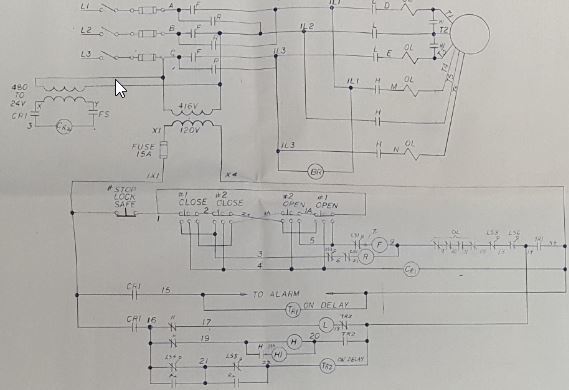generatorlabs
Industrial
- May 21, 2016
- 7
Working on replacing a starter on an abandoned warehouse. The starter is basically destroyed and missing major parts.
The motor is a 5 hp, two winding, 3 phase motor, running at 480. The starter will be reversible. The motor is being rewound.
I have not worked on a separate winding motor before however I have full drawings for the original starter.
The drawings are from the 1950's. They are a little sparse.
My question is:
a) When going from LO to HI speed, should a delay timer be inserted between the LO speed and HI speed contactors with this motor design? If so what delay time?
b) I see that the LO speed winding should be shunted when running at HI speed. Why is it shunted if the windings are separate? Is that to quelch induced currents?
c) I am assuming I will just use another contactor for shunting. Does the shunting contactor require the same specs as the Lo, Hi, Forward & Reverse contactors?
Just for FYI, I am using ABB contactors. They are IEC frame. I have chosen IEC frames sizes equivalent to NEMA1 contactors. All mechanical/electrical contactor interlocks will be in place.
Any advice appreciated!
The motor is a 5 hp, two winding, 3 phase motor, running at 480. The starter will be reversible. The motor is being rewound.
I have not worked on a separate winding motor before however I have full drawings for the original starter.
The drawings are from the 1950's. They are a little sparse.
My question is:
a) When going from LO to HI speed, should a delay timer be inserted between the LO speed and HI speed contactors with this motor design? If so what delay time?
b) I see that the LO speed winding should be shunted when running at HI speed. Why is it shunted if the windings are separate? Is that to quelch induced currents?
c) I am assuming I will just use another contactor for shunting. Does the shunting contactor require the same specs as the Lo, Hi, Forward & Reverse contactors?
Just for FYI, I am using ABB contactors. They are IEC frame. I have chosen IEC frames sizes equivalent to NEMA1 contactors. All mechanical/electrical contactor interlocks will be in place.
Any advice appreciated!


